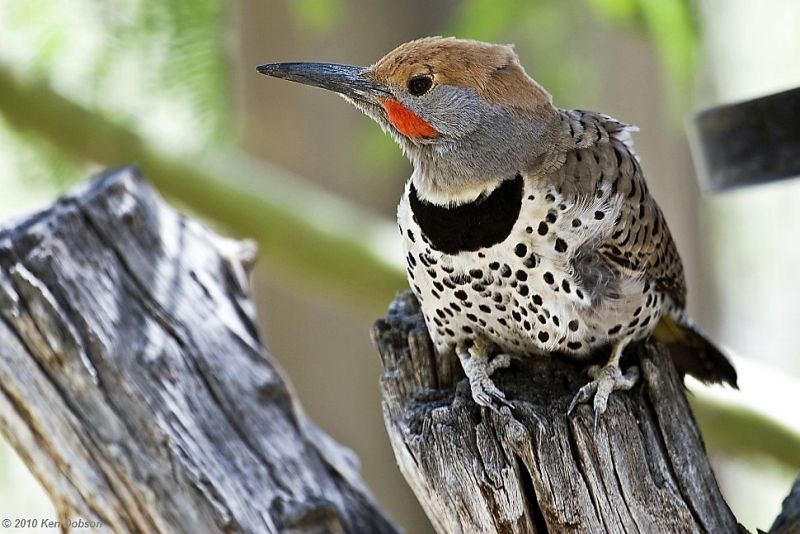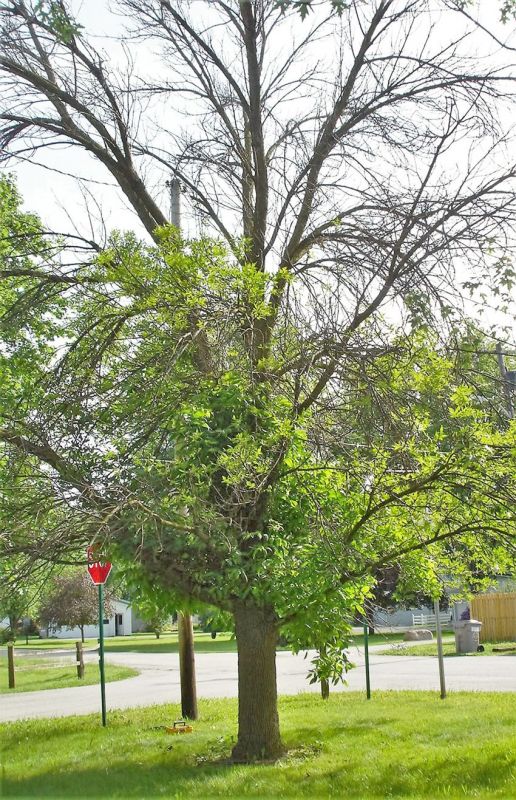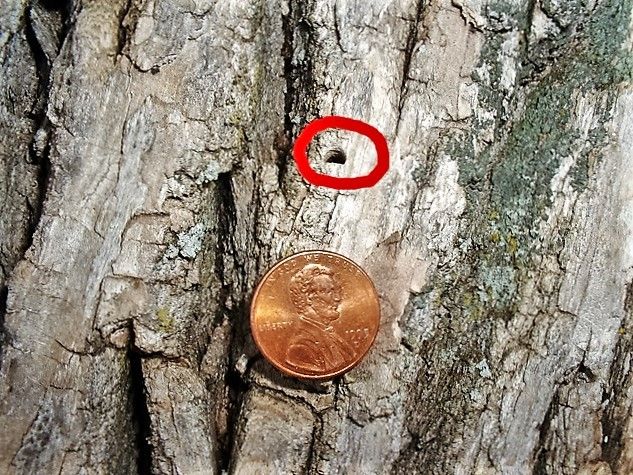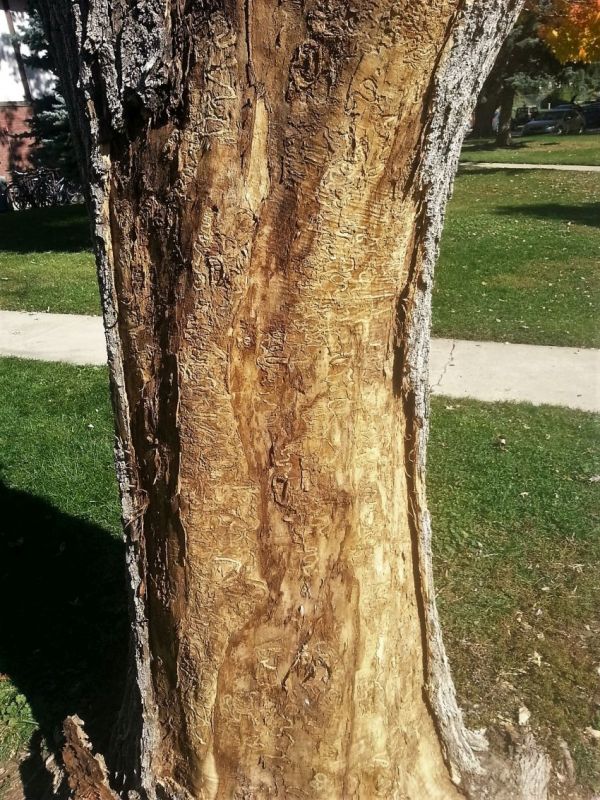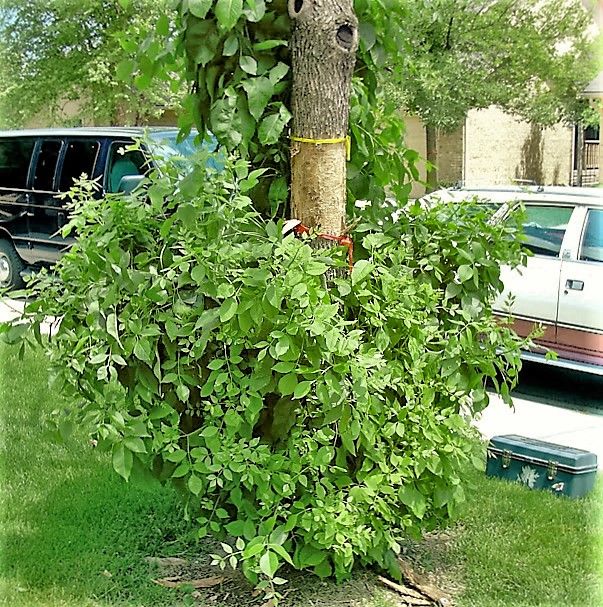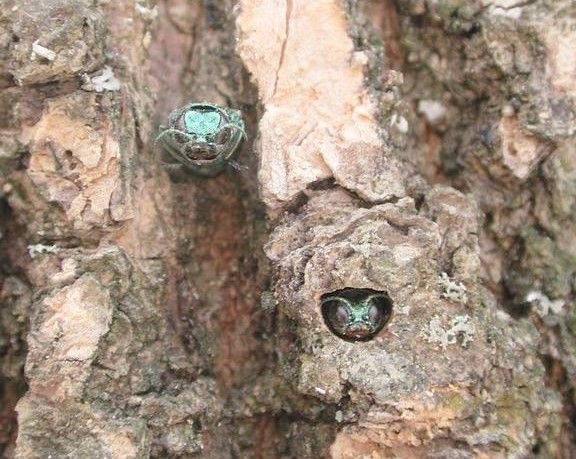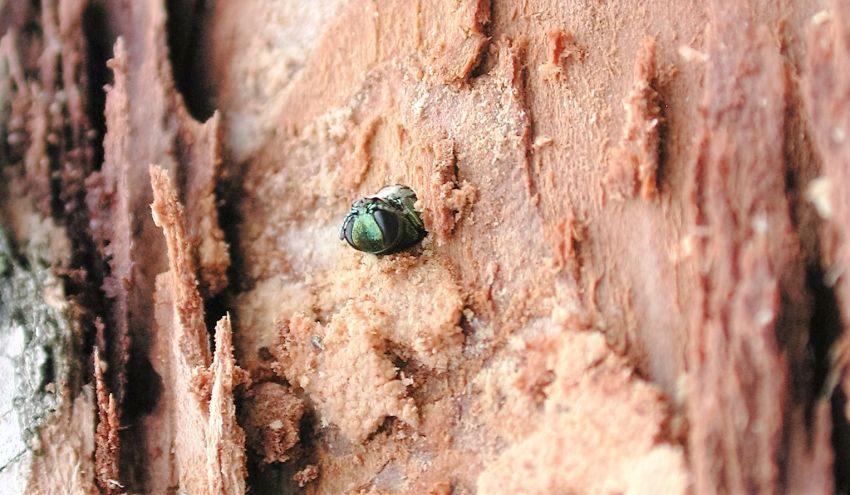EMERALD ASH BORER TREATMENT
How to Protect Your Ash Tree from the Emerald Ash Borer
Emerald Ash Borer (EAB)
The Emerald Ash Borer (EAB) has killed over 50 million ash trees across more than 20 states, posing a severe threat to urban forests. To put this into perspective, just as the Mountain Pine Beetle has devastated Colorado’s forests, the EAB could have a similarly destructive impact if left unchecked. According to the Colorado Department of Agriculture, one in five trees in the state is an ash tree, making proactive protection crucial. The good news is that there are effective treatments are available to safeguard ash trees and preserve our urban forest.
Which Colorado Cities Has the Emerald Ash Borer Been Discovered?
The Emerald Ash Borer (EAB), a highly destructive invasive beetle that has decimated millions of ash trees across North America, has now been confirmed in multiple cities throughout Colorado. Below is a list of Colorado cities where EAB has been discovered and the year they were found.
Boulder (2013)
Gunbarrel (2013)
Longmont (2013)
Lafayette (2013)
Lyons (2013)
Superior (2013)
Broomfield (2019)
Erie (2019)
Arvada (2020)
Thornton (2022)
Littleton (2023)
Carbondale (2023)
Lakewood (2024)
Emerald Ash Borer
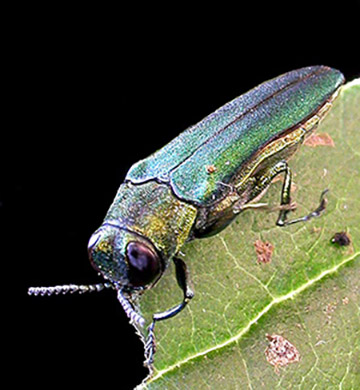
Treatment Plan for EAB
ASAP – Treat All Ash Trees Using TREE-äge
Effectively controlling the Emerald Ash Borer (EAB) requires a proactive strategy, as infested trees have a low chance of survival. The best way to protect ash trees is through direct trunk injections with TREE-äge® (emamectin benzoate), a systemic insecticide that provides up to two years of protection. This treatment not only eliminates larvae that could be living inside the trunk of the tree, but it also prevents future attacks, ensuring long-term tree health.
Two Years After Initial TREE-äge® Treatment: Start Annual Soil Drench Applications
After the initial TREE-äge® treatment, applying a soil drench with Criterion® (imidacloprid) annually provides an additional year of protection for the tree. However, if a tree is already severely infested—exhibiting more than 50% canopy loss—removal may be necessary to prevent the further spread of beetles.
Preventative Treatments are a Must-Do!
Preventative treatment is key, as unprotected trees have little chance of survival once EAB takes hold. Even regularly monitoring trees for early signs of Emerald Ash Borer (EAB) infestation—such as thinning canopies, D-shaped exit holes, and bark splitting—may not be enough to save a tree from an attack resulting in death. This is the rare case where preventative insecticide treatments are the only way to fully protect an ash tree from an infestation and almost certain death.
Trunk Injection with TREE-äge
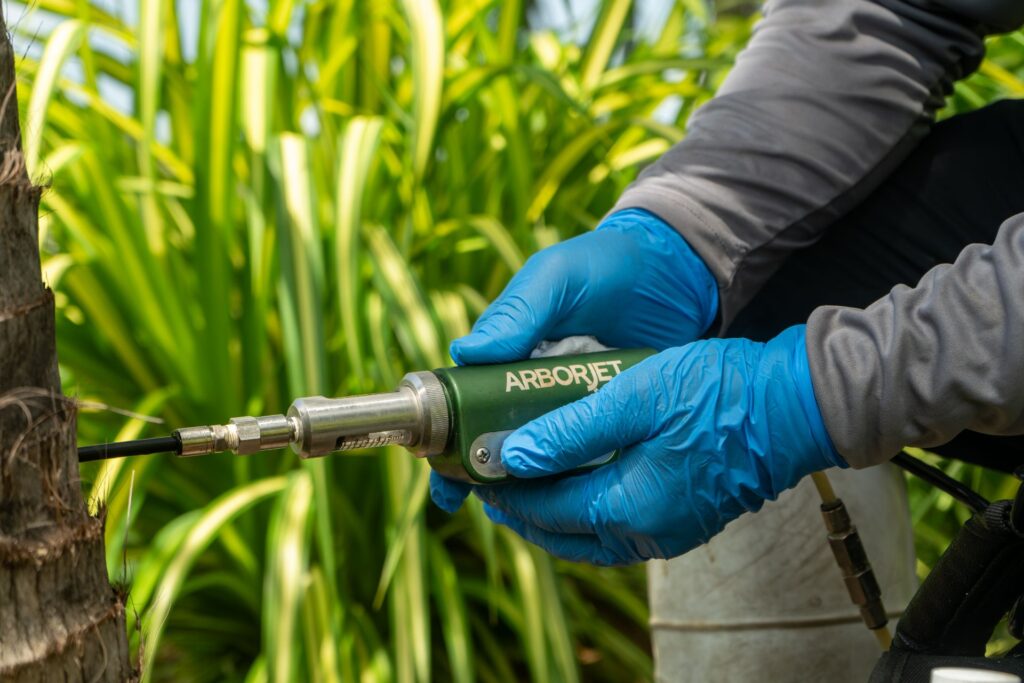
Pricing for EAB Treatment
Based on Trunk Diameter (DBH)
Pricing for Trunk Injection
Using Tree-äge®
(Emamectin Benzoate)
Recommended for 1st Treatment
(Kills Larvae and Protects)
Up to 2 Years of Control
Tree Trunk Diameter (DBH)** – Cost Per Tree
2-8″ – $147.00
9″ – $159.50
10″ – $172.00
11″ – $184.50
12″ – $197.00
13″ – $209.50
14″ – $222.00
15″ – $234.50
16″ – $247.00
17″ – $261.50
18″ – $274.00
19″ – $286.50
20″ – $306.50
21″+ – Call for Pricing
Volume Discounts:
5% off between $200-$300
10% off between $300-$500
15% off for $500+
** DBH = (Diameter Breast Height)
TREE-äge® Pesticide Fact Sheets
EPA Registration Number for TREE-äge®
EPA Reg. No. 74578-10
TREE-äge® is also registered with the Colorado Department of Agriculture.
Pricing for Soil Drench Applications Using Criterion
(Imidacloprid)*
Recommended Yearly Treatments Starting in Year 3 (Prevention Only)
Up to 1 Year of Control
Tree Trunk Diameter (DBH)** – Cost Per Tree
Flowers – $4.75
Small Shrubs 6″ or Less – $7.00
Medium Shrubs 6-18″ – $10.00
Large Shrubs 18″ or Taller – $14.50
1″ Tree Trunk Diameter – $18.00
2″ Tree Trunk Diameter – $22.50
3″ Tree Trunk Diameter – $27.25
4″ Tree Trunk Diameter – $32.00
5″ Tree Trunk Diameter – $36.75
6″ Tree Trunk Diameter – $41.25
7″ Tree Trunk Diameter – $46.00
8″ Tree Trunk Diameter – $50.75
9″ Tree Trunk Diameter – $55.25
10″+ – Call for Pricing
Volume Discounts:
5% off orders over $100.00
10% off over $200.00
15% off over $300.00
** DBH = (Diameter Breast Height)
Criterion Pesticide Fact Sheets
CRITERION LABEL
CRITERION SDS
IMIDACLOPRID FACT SHEET
EPA Registration Number for Criterion 75 WSP
EPA Reg. No. 432-1318
Criterion 75 WSP is also registered with the Colorado Department of Agriculture.
How to Measure
a Tree's Trunk Diameter
Proper Lawn Watering can Reduce Insect Pressure on Tress
Schedule a Tree-age Treatment for Emerald Ash Borer
Professional Tree Care Service
We understand that insect controls for trees can be confusing due to the many nuances of how each product works. If you have any questions about the Emerald Ash Borer or if you want to talk with a tree care expert please contact our office to answer your tree care questions.
Boulder (303) 499-2000 and Fort Collins (970) 225-9425
Symptoms of Emerald Ash Borer Pressure
Woodpercker Activity
Canopy Dieback
A Closer Look at the Emerald Ash Borer
Emerald Ash Borer
The Life Cycle of the Emerald Ash Borer
From Egg to Adult
The Emerald Ash Borer (EAB) follows a one- to two-year life cycle, depending on climate conditions. It progresses through four distinct stages: egg, larva, pupa, and adult, with most of the damage occurring during the larval stage.
Egg Stage (Late Spring – Early Summer)
- Female EAB beetles lay eggs in bark crevices of ash trees.
- Eggs hatch in 7-10 days.
Larval Stage (Summer – Fall, Sometimes Overwintering to Spring)
- Newly hatched larvae burrow beneath the bark, feeding on the tree’s vascular tissue.
- This feeding creates S-shaped galleries, cutting off the tree’s ability to transport nutrients and water.
- Larvae grow through four instars, reaching up to 1.5 inches long before entering the next stage.
Pupa Stage (Late Fall – Early Spring)
- In cold climates like Colorado, larvae overwinter under the bark.
- Pupation occurs in spring inside the tree, as temperatures warm.
Adult Stage (Spring – Summer)
- Mature beetles emerge through D-shaped exit holes in the bark, starting in late May through July.
- Adults live for about 3-6 weeks, feeding on ash tree leaves before mating and laying eggs, continuing the cycle.
The Most Destructive Stage
The larval stage is the most destructive, as it kills trees by girdling their vascular system. TREE-äge trunk injections can prevent and stop infestations by killing larvae before they cause irreversible damage.
Emerald Ash Borer Life Cycle
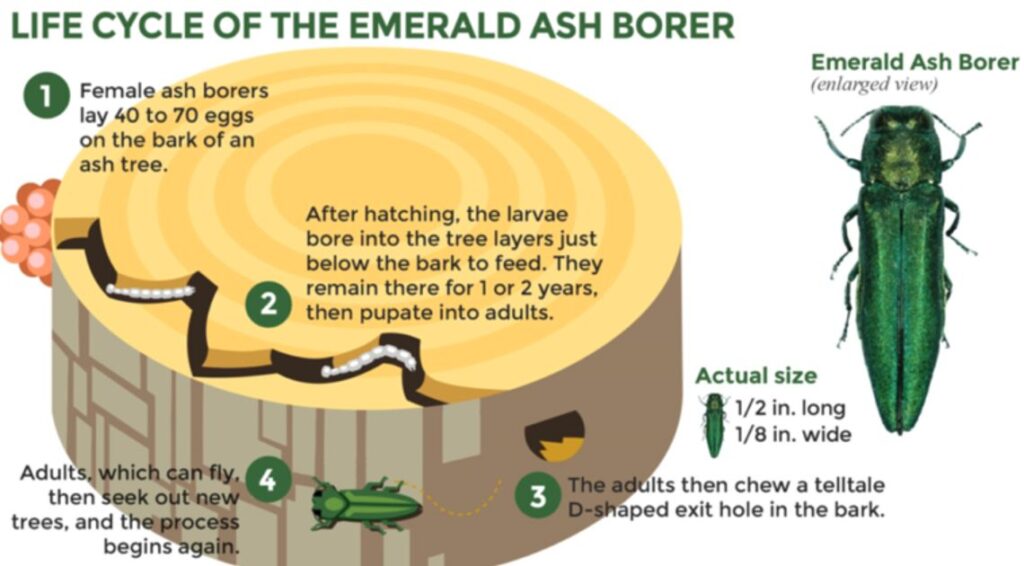
Emerald Ash Borer
Emerald Ash Borer FAQs
Are Ash Trees the Only Trees at Risk from Emerald Ash Borers?
In North America, ash trees are the only tree species vulnerable to attacks from the emerald ash borer (EAB). Both forest trees and those in urban landscaped areas can be affected. Larval galleries made by EAB larvae have been discovered in trees or branches as small as 1 inch in diameter. All species of ash trees in North America are susceptible to EAB infestation.
Where did the Emerald Ash Borer Come From?
The Emerald Ash Borer (EAB) is an invasive beetle native to northeastern Asia, specifically China, Japan, Korea, Mongolia, and eastern Russia. It was first discovered in North America in 2002, near Detroit, Michigan, and Windsor, Ontario. Researchers believe EAB arrived in the late 1990s through infested wood packaging material used in international shipping. With no natural predators in North America, EAB rapidly spread, killing millions of ash trees across the U.S. and Canada. Its destructive impact has led to quarantine zones, tree removal programs, and the need for proactive insecticide treatments like TREE-äge to protect ash trees from infestation.
The Emerald Ash Borer (EAB) (Agrilus planipennis) is an invasive beetle from Asia that attacks and kills ash trees by tunneling beneath the bark, cutting off water and nutrient flow.
- Larvae burrow under the bark, creating S-shaped galleries that cut off the tree’s nutrient supply.
- Tree decline begins within a year, with full canopy dieback in 3-5 years.
- Adults emerge through D-shaped exit holes, spreading to new trees.
Signs of Infestation Include
✔️ Thinning canopy and dieback starting at the top.
✔️ D-shaped exit holes in the bark.
✔️ S-shaped galleries under the bark.
✔️ Woodpecker activity (they feed on larvae).
✔️ Shoots or suckers sprouting from the base.
EAB can spread naturally (via flying adults) about 10-15 miles per year, but human transport of infested wood significantly accelerates its spread.
The best time to treat is BEFORE an infestation occurs!
- Early spring to early summer is the best time for injections.
- If EAB is confirmed nearby, don’t wait—treat now!
If an ash tree is untreated and heavily infested (more than 50% canopy loss), removal may be necessary to prevent hazards from falling limbs and further EAB spread.
TREE-äge® FAQs
How often does TREE-äge® need to be applied?
TREE-age will last in a tree for 2-3 years. We recommend an application every 2 to 3 years, depending on the tree species and the type of insect that we want to control or prevent.
How Long Does a TREE-äge® Trunk Injection Last?
1-2 Years
TREE-äge (emamectin benzoate) provides long-lasting protection once injected into a tree’s vascular system. The duration of its effectiveness depends on pest pressure, tree health, and environmental conditions.
- Up to 2 years of protection against wood-boring pests like Emerald Ash Borer (EAB), Bronze Birch Borer, and Pine Bark Beetles.
- 1-2 years of control for Zimmerman Pine Moth, Lilac/Ash Borer, and other borers.
- Typically lasts one full growing season for leaf-feeding pests like caterpillars and leafminers.
Systemic Insectide
Since TREE-äge is systemic, it moves through the tree’s vascular system, protecting current and future growth during this period. Reapplications are typically needed every two years for high-risk trees.
Additional TREE-äge® FAQs
Drilling small holes for Arborjet trunk injections does cause minor wounding, but when done correctly, it does not significantly harm the tree and is far less damaging than the effects of untreated pests or diseases. The holes are small, strategically placed, and designed to heal over time.
No; we leave the plugs in the tree.
The plugs used in trunk injections serve an important role in ensuring efficient insecticide delivery, reducing tree damage, and promoting healing. These small, specialized plugs are inserted into the drilled injection sites and remain in the tree after treatment.
The time required to complete this tree care service can range from 5 minutes to 8 hours. This duration depends on several factors, including the health of the tree, the moisture level of the soil, and the outside temperature. In cases where the tree is absorbing water very slowly, we may leave the equipment connected and return the next day to retrieve it.
Once TREE-äge is injected into a tree, the time it takes for the insecticide to fully distribute through the vascular system depends on several factors, including tree size, health, and environmental conditions.
Estimated Uptake Time
- Small Trees (5-10 inches in diameter): 2-4 weeks
- Medium Trees (10-20 inches in diameter): 4-6 weeks
- Large Trees (20+ inches in diameter): 6-8 weeks or longer
Factors Affecting Uptake Speed
- Tree Health – Healthy trees with active sap flow absorb the insecticide more quickly.
- Soil Moisture – Proper watering before and after injection improves uptake. Drought-stressed trees absorb more slowly.
- Temperature & Season – Uptake is fastest when the tree is actively growing (spring to early summer). Cold weather slows absorption.
- Tree Species – Some species, like ash and birch, transport TREE-äge faster than dense hardwoods like oak.
When Does TREE-äge Start Working?
- Sap-feeding pests (e.g., aphids, leafhoppers): 4-6 weeks after injection.
- Wood-boring insects (e.g., Emerald Ash Borer, Bronze Birch Borer): 6-8 weeks for full systemic protection.
Anytime that the tree has leaves, typically about May through September.
The duration of this treatment typically lasts between 1 to 3 years, depending on the specific insect being treated. If the insect poses a fatal threat to your tree, consider scheduling another treatment after 2 years. However, if the insect only weakens the tree without causing death, a treatment after 3 years may suffice. For cases involving the Emerald Ash Borer, we may transition to annual root injections following the initial Tree-Age treatment.
We are unsure about treating trees with a diameter at breast height of less than 2 inches. While we have had good results with smaller trees in the past, we cannot guarantee that they will survive the treatment. Therefore, it is not recommended to treat trees below this size, as we cannot ensure their safety during the process.
Once injected, TREE-äge is absorbed into the tree’s vascular system, providing long-lasting protection by targeting insects as they feed on the tree’s tissues. It effectively kills larvae inside the tree and prevents adult infestations.
Yes! TREE-äge is most effective as a preventative treatment. If a tree is already infested, treatment may still help, but early application ensures the best protection.
Yes, and No! TREE-äge can be used reactively, but it is most effective as a preventative treatment. When applied to a tree that is already infested, TREE-äge can help stop further damage by killing active larvae and preventing new infestations, but it cannot reverse existing structural damage caused by pests like Emerald Ash Borer (EAB), Bronze Birch Borer, or Pine Bark Beetles.
Limitations of Reactive Treatment
- TREE-äge cannot repair structural damage or regrow lost canopy.
- If more than 50% of the canopy is lost, survival chances decrease significantly.
- Severely infested trees may still decline, even after treatment.
- For Reactive Treatment of Emerald Ash Borer – Typically if an ash tree is showing signs of damage it is too late to save the tree.
